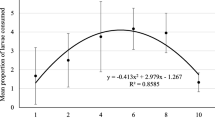Abstract
The functional response in terms of prey consumption and numerical response in terms of number of eggs laid by individual female adult predators of Coccinella transversalis Fab. and Cheilomenes (Menochilus) sexmaculatus Fab. (Coccinellidae: Coleoptera) at varied prey (Aphis gossypii Glover) (Aphididae: Homoptera) densities were investigated under laboratory conditions. The feeding rate by individual predators increased at increased prey densities, with both the coccinellids showing the Type II functional response. One hundred percent prey consumption was observed up to an initial prey density of 50 and 20 for Co. transversalis and Ch. sexmaculatus respectively. The fecundity of Co. transversalis increased at higher prey densities, but that of Ch. sexmaculatus remained unchanged.
Résumé
La réponse fonctionnelle en termes de prédation et la réponse numérique reflétée par le nombre d’oeufs individuellement pondus par les femelles matures de Coccinella transversalis Fab. et Cheilomenes (Menochilus) sexmaculatus Fab. (Coleoptera: Coccinellidae) a été étudiées dans des conditions de laboratoire, sur des densités variées de proie du puceron, Aphis gossypii Glover (Homoptera: Aphididae). Le taux de consommation par les prédateurs isolés allait de pair avec l’augmentation de la densité de proie et toutes les deux coccinelles montraient une réponse de prédation du Type II. Avec une densité respective de 50 et 20 pucerons, on a enregistré 100% de prédation pour C. transversalis et C. sexmaculatus. Chez C. transversalis, la fécondité augmentait avec l’accroissement de la densité de proie tandis que chez C. sexmaculatus cette fécondité est restée inchangée.
Similar content being viewed by others
References
Agarwala B. K. and Ghosh M. R. (1985) Biogeographical considerations of India Aphididae (Homoptera). Ins. Matsum. N.S. 31, 1–16.
Agarwala B. K. and Saha J. L. (1986) Larval voracity, development and relative abundance of predators of Aphis gossypii on cotton in India, pp. 339–344. In Ecology of Aphidophaga (Edited by I. Hodek), The Netherlands.
Arditi R. (1983) A unified model of the functional response of predators and parasitoids. J. tAnim. Ecol. 52, 293–303.
Baskaran P. and Sambasivam A. (1984) A note on aphidophagous coccinellids and syrphids found at Annamalainagar, Tamil Nadu. Madras Agric. J. 71, 204–205.
Butani D. K. and Jotwani M. G. (1984) Insect pests of vegetables and their control. Pesticides XV, 33–37.
Hassell M. P., Lawton J. H. and Beedington J. R. (1976) The components of arthropod predation I. The prey death rate. J. tAnim. Ecol. 45, 135–164.
Hodek I. (1973) Biology of Coccinellidae. Academic, Prague, 260 pp.
Holling C. S. (1959) The components of prédation as revealed by a study of small mammal population of European pine sawfly. Can. Entomol. 91, 293–320.
Holling C. S. (1965) The functional response of prédation to prey density. Mem. Entomol. Soc. Can. 48, 1–96.
Ives P. M. (1981) Feeding and egg production of two species of coccinellids in the laboratory. Can. Entomol. 133, 99–105.
Kawauchi S. (1977) Effect of the different prey density on the food consumption of Propylea japonica Thunberg. (Col., Coccinellidae). Kurume Univ. J. 26, 67–71.
Lawton J. H., Hassell M. P. and Beedington J. R. (1975) Prey death rates and the rate of increase of arthropod predator population. Nature 255, 60–62.
Livdahl T. P. and Stiven A. E. (1983) Statistical difficulties in the analysis of predator functional response data. Can. Entomol. 115, 1365–1370.
Mills N. J. (1982) Voracity, cannibalism and coccinellid predation. Ann. Appl. Biol. 101, 144–448.
Murdoch W. W. (1972) Quantitative evaluation of natural enemy effectiveness. 14th International Congress of Entomology Symposium, Canberra, 335–341.
Ofuya T. I. (1986) Predation by Cheilomenes vicina (Coleoptera: Coccinellidae) on the cowpea aphids, Aphis craccivora (Homoptera: Aphididae) effect of prey stage and density. Entomophaga 31, 331–335.
Pandey K. P., Kumar A., Singh R. and Shankar S. (1984) Numerical response and area of discovery of a predator, Coccinella septempunctata L. Z. Angew. Entomol. 97, 410–423.
Popov P. (1960) Role of Coccinella septempunctata L. in the biological control of aphids. Seiskostop. Misul, Sofia 152–153.
Radke S. G., Darward W. L. and Mundiwale S. K. (1977) Influence of age of predator Coccinella septempunctata L. and population densities of the host Rhopalosiphum malais (Fitch.) (Homoptera: Aphididae) on the rate of predation. Indian J. Agric. Sci. 47, 305–308.
Readshaw J. L. (1973) The numerical response of predators to prey density. J. tAppl. Ecol. 10, 242–351.
Rogers D. J. (1972) Random search and insect population models. J. tAnim. Ecol. 41, 369–383.
Royama T. (1971) A comparative study of models for predation and parasitism. Res. Popul. Ecol. Kyoto Univ. Suppl. 1, 91.
Saharia D. (1983) Some aspects of the biology of three coccinellid predators of Myzus persicae (Sulz.) on eggplant. J. Res. Assam. Agric. Univ. 4, 78–82.
Sambasivam A. (1982) Studies on certain aphidophagous predators of Annamalainagar with reference to their biology and predatory potential. MSc (Agric.) Thesis, Annamalai Univ., Annamalainagar, India.
Shands W. A. and Simpson G. W. (1972) Insect predators for controlling aphids on potatoes 2. In small plots with two kinds of barriers, in smaller fields or in large cages. J. tEcon. Entomol. 65, 514–518.
Sinha T. B., Pandey R. K., Rajendrasingh, Tripathi C. P. M. and Kumar A. (1982) The functional response of Coccinella septempunctata Linn., a coccinellid. Entomon. 7, 7–10.
Waage J. (1990) Ecological theory and selection of biological control agents, pp. 135–157. In Critical Issues in Biological Control (Edited by M. Mackaner, L. E. Enler and J. Roland). Intercept, Andover.
Author information
Authors and Affiliations
Additional information
See Editor’s Note at the end of this issue.
Rights and permissions
About this article
Cite this article
Veeravel, R., Baskaran, P. Functional and Numerical Responses of Coccinella Transversalis Fab. and Cheilomenes Sexmaculatus Fab. Feeding on the Melon Aphid, Aphis Gossypii Glov.. Int J Trop Insect Sci 17, 335–339 (1997). https://doi.org/10.1017/S1742758400019159
Accepted:
Published:
Issue Date:
DOI: https://doi.org/10.1017/S1742758400019159
Key Words
- functional response
- numerical response
- Coccinella transversalis
- Cheilomenes sexmaculatus
- Aphis gossypii
- eggplant
- prey density




